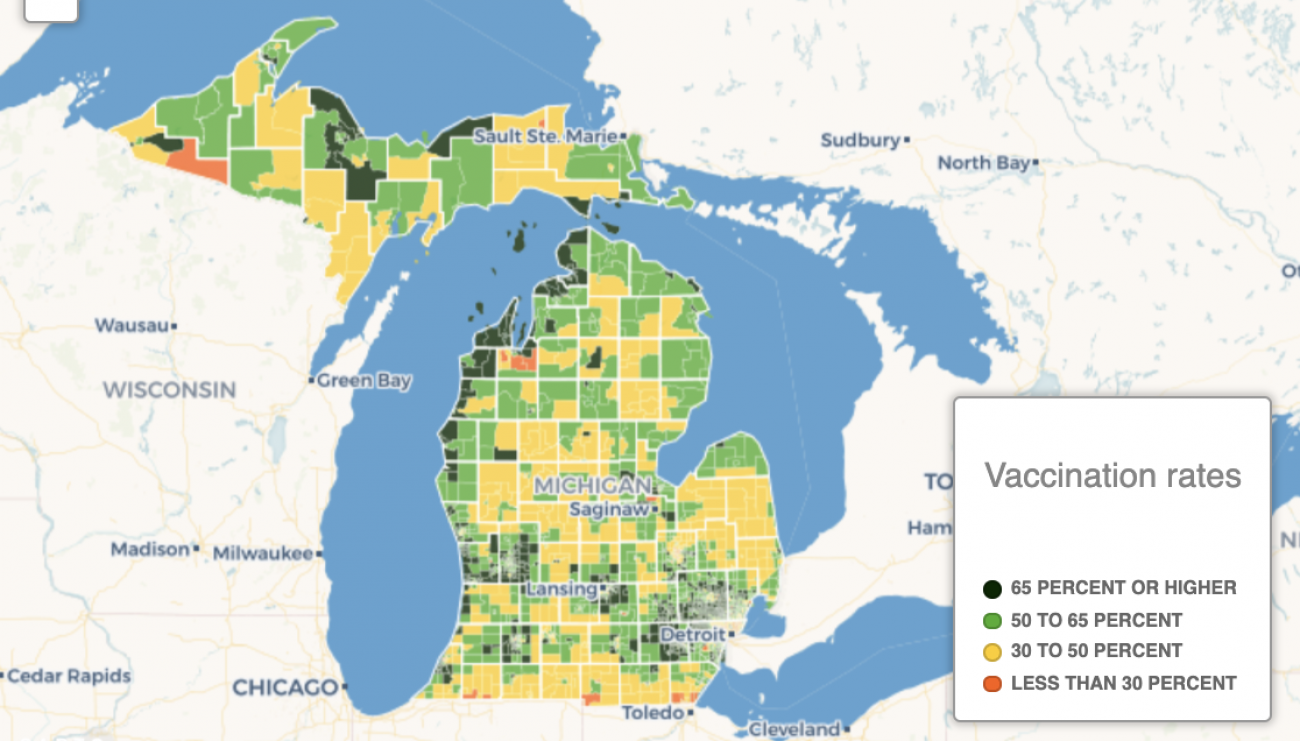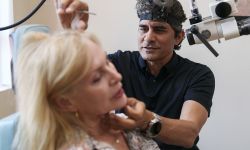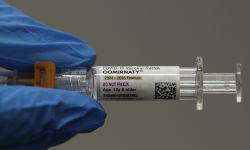Education levels drive Michigan vaccines. What’s rate in your neighborhood?

In July, volunteer advocates of the COVID-19 vaccine fanned out across Battle Creek, spending six weeks trying to persuade 1,900 unvaccinated residents to get the shot.
They got 16 takers.
Across the state near Saginaw Bay, after months of outreach, from a local raffle to door-knocking, hostility from residents caused Bay County to discontinue efforts to encourage vaccines in some rural areas.
Related:
- After 18 months: Welcome back, Canada, if you’re vaccinated
- Michigan ER patients left on stretchers, then recliners, in swamped wards
- Michigan college COVID outbreaks plummet as students vaccinate and mask up
- 400 workers out, 1,900 exempt after Henry Ford COVID vaccine mandate
- COVID outbreaks in Michigan schools already 8 times higher than last year
- Science says school masks work. Public opinion is another issue in Michigan
“To go door-to-door and deal with some of the invective and abuse, it’s not worth it,” said Joel Strasz, health officer for the Bay County Health Department.
Vaccinations in Michigan and much of the nation have waned significantly since spring, despite carrot-and-stick approaches from state and federal officials, including Michigan’s $5 million vaccine lottery and President Joe Biden’s mandate for companies with 100 or more employees.
In the past month, 137,000 Michigan residents have gotten fully vaccinated, compared to 1.6 million in May. That’s stalled the state’s inoculation rate at 52 percent of those 16 and older, compared to 56 percent nationwide.
Link between vaccination and education in Michigan
Across Michigan, vaccination rates vary widely, with more than 90 percent in some regions and fewer than 20 percent in others. Although no single factor predicts what the rate will be, a Bridge Michigan analysis of census-tract level data shows a strong link with education: the higher the percentage of college grads, the higher the vaccination rate is. Use the maps below to see what the vaccination and grad rates are across the state. You can use the ‘search’ box to find your community.
Vaccination rates
College grad rates
Note: Some communities along the borders with Ohio, Indiana and Wisconsin have lower vaccination rates. In many cases, residents in those communities have been vaccinated in neighboring states and those inoculations are not in the state’s data set.
Sources: Michigan Department of Health and Human Services data, U.S. Census
If there were a magic bullet, a single marketing pitch that would turn doubters into believers, health officials said they haven’t found it yet. Instead, what they’ve found is there are factors that can predict success but are hard to overcome: education, age and affluence.
“The secret is there is no secret. Sorry, it’s all demographics,” Strasz said.
Simply put: Older and educated residents have lined up for the vaccines, which have been determined to be extremely effective in the fight against COVID-19.
A Bridge Michigan analysis of vaccine rates in the state’s nearly 3,000 census tracts shows a strong correlation between education levels and vaccination rates.
It’s a trend that holds true throughout the state, from predominantly white parts of the Thumb to predominantly Black areas of cities including Detroit, Flint and Muskegon.
Despite well-known political differences, areas of rural and urban poverty generally have far lower vaccination rates than more affluent, educated areas, regardless of their political leadings.
Take Bay County and Calhoun County, home to Bay City and Battle Creek.
In Bay County, Frankenlust Township has the county’s highest vaccination rate, with 69 percent of those 16 and older fully vaccinated. It’s also the most-educated part of the county too, with nearly 40 percent of adults having college degrees.
Just east of the township, in two census tracts of Bay City along the Saginaw River, fewer than 10 percent of adults have a college degree — and fewer than 45 percent are fully vaccinated.
Much has been made of the political divide on vaccinations, with Republicans telling pollsters they are far less likely to get vaccine than Democrats.
But the Bridge analysis suggests that education is also a strong driver of vaccines.
Frankenlust Township backed former President Donald Trump, while Bay City backed Democratic President Joe Biden.
The same pattern holds in Calhoun County: southwest Battle Creek has both the highest vaccination rate (79 percent) and the greatest percentage of college grads (36 percent) even though it backed Trump.
Areas of the central city have the lowest vaccination rates, some below 40 percent, and the fewest college grads. The neighborhoods went big for Biden.
Overall, 30 percent of Michigan adults have college degrees, ranking 34th among states in education and 27th in vaccination rate.
Nationally, the 10 states with the highest vaccination rates all have above-average rates of college grads, and most are the top 10.
The trends hold true in Michigan:
- In Grosse Pointe Farms and Grosse Pointe Shores, where Trump bested Biden, over 60 percent have college degrees and over 90 percent of those 16 and older are fully vaccinated.
- In most of nearby Detroit, where Biden won over 90 percent of the vote, less than half of residents are vaccinated. In many areas , the rate is less than a third, especially in neighborhoods where fewer than 10 percent of adults have a college degree.
- In the Thumb, a farming area with lower education rates, fewer than half of residents in many communities are vaccinated.
- In Grand Traverse County, where Traverse City backed Biden but much of the rest of the county backed Trump, the highest vaccination rates are in the areas with more college grads.
‘Fear and misinformation’
Every week, even as new COVID-19 cases rise in Michigan and millions remain unvaccinated, the number of people choosing to get the shots is dwindling.
Months after huge drive-through clinics have been staged at stadiums, pharmacies are offering the vaccines and some providers have taken the vaccines to individual doorsteps.
But the push to get the last holdouts has been grueling.
In Battle Creek, vaccine ambassadors spent six weeks talking with 1,900 people who had not been vaccinated, said Angela Stewart, community initiatives officer for the Battle Creek Community Foundation.
A recent family health night at a local elementary school, promoted over two days, led to five new vaccinations, she said.
Bay County and Battle Creek officials said that, despite local, state and national campaigns, many remain fearful of the vaccine or believe bad information they’ve heard on social media or from friends.
“There still is that fear and misinformation,” Stewart said.
“Economically, it makes no sense at all not to get vaccinated,” he said. “They’re willing to gamble with it and that’s distressing.”
But there are still many demographics that have set aside fear.
Over 72 percent of those 65 and older — by far the most likely to die if they contract COVID-19 — are fully vaccinated in Michigan, state records show.
‘Stay focused’
In Albion in southwestern Michigan, Rod Auton, administrator of the nonprofit Albion Health Care Alliance, said his team of 17 ambassadors is still going door-to-door, trying to make the sale.
It is slow going; a recent event generated fewer than 10 vaccinations, he said.
In Albion, between 32 percent and 48 percent of people are vaccinated, according to census tract data. All areas have a lower percentage of college grads. In 2020, the city supported Biden.
“We know we just have to stay focused and provide good information,” Auton said.
But aware that many of the hesitant are more likely to listen to family and friends or their employers than local health officials, they’ve come up with postcards with two local doctors — one white and one Black — pointing out the value of the vaccines.
They’re sending them across Albion and into neighboring townships, with the postcard of the Black doctor targeted to African-American communities and the white doctor to white communities.
The alliance is hoping the postcards will work, Auton said. But like Strasz, he’s looking for that perfect argument, that key piece of information that will unlock hesitancy. So far, he hasn’t found it.
“We’re still trying to figure out that magic,” Auton said.
See what new members are saying about why they donated to Bridge Michigan:
- “In order for this information to be accurate and unbiased it must be underwritten by its readers, not by special interests.” - Larry S.
- “Not many other media sources report on the topics Bridge does.” - Susan B.
- “Your journalism is outstanding and rare these days.” - Mark S.
If you want to ensure the future of nonpartisan, nonprofit Michigan journalism, please become a member today. You, too, will be asked why you donated and maybe we'll feature your quote next time!








